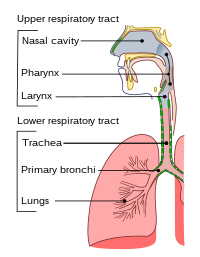
Photo from wikipedia
Background: Primary pulmonary malignancies (PPMs) and non-pulmonary malignancies (PNPMs) may result in airway stenosis requiring stenting. This study aimed to compare and evaluate the clinical features and stent placement outcomes… Click to show full abstract
Background: Primary pulmonary malignancies (PPMs) and non-pulmonary malignancies (PNPMs) may result in airway stenosis requiring stenting. This study aimed to compare and evaluate the clinical features and stent placement outcomes of airway stenosis caused by PPMs and PNPMs. Methods: A total of 141 patients with malignant airway stenosis who underwent Micro-Tech stent placements between January 2004 and October 2017 at Department of Respiratory Medicine, Beijing Tian Tan Hospital, Capital Medical University were divided into PPM (n = 100) and PNPM groups (n = 41). Patients’ clinical features and stent placement outcomes were collected and analyzed. Chi-square test was used to compare the categorical variables, while independent- or paired-sample t test was used to compare the continuous variables. Results: There were no significant differences in age, sex, treatment history, respiratory symptoms, and incidence of obstructive pneumonia between groups. Multiple airway involvement (63.0% vs. 31.7%; &khgr;2 = 11.459, P = 0.001) and atelectasis (17.0% vs. 2.4%; &khgr;2 = 5.536, P = 0.019) were more common in the PPM group, while extraluminal obstruction (24.4% vs. 6.0%; &khgr;2 = 8.033, P = 0.005) was more common in the PNPM group. Before stenting, the American Thoracic Society Dyspnea Index (ADI) and Karnofsky Performance Scale (KPS) scores showed no significant differences between groups (all P > 0.05). After stenting, a satisfactory rate of symptom improvement was achieved in both groups (98.0% and 100.0% in the PPM and PNPM groups, respectively; &khgr;2 = 0.016, P = 0.898); ADI and KPS scores, which showed no significant differences between groups (all P > 0.05), were significantly improved in each group (all P < 0.001). Complications after stenting could be effectively managed using bronchoscopic procedures. Conclusions: Among cases of malignant airway stenosis requiring stenting, those caused by PPM are more likely to involve multiple airways and are associated with atelectasis, while those caused by PNPM are more likely to cause extraluminal obstruction. Micro-Tech stent placement has the same immediate effect in terms of improvement in respiratory symptoms and performance status for both malignant airway stenosis caused by PPM and that caused by PNPM.
Journal Title: Chinese Medical Journal
Year Published: 2019
Link to full text (if available)
Share on Social Media: Sign Up to like & get
recommendations!